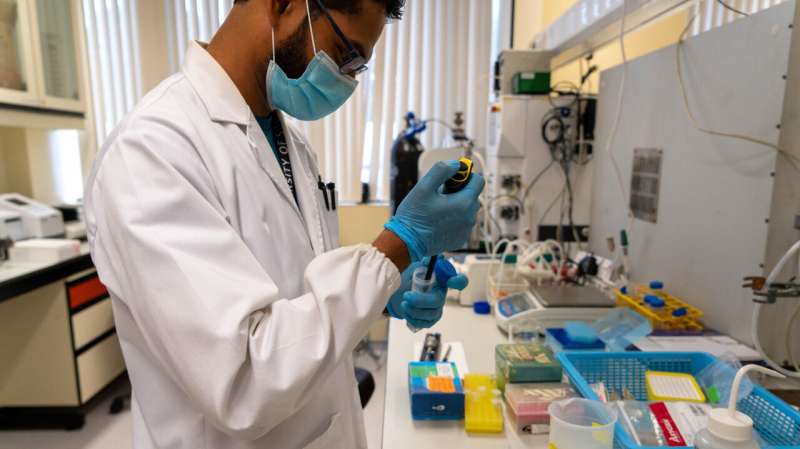This article has been reviewed according to Science X's editorial process and policies. Editors have highlighted the following attributes while ensuring the content's credibility:
fact-checked
peer-reviewed publication
trusted source
proofread
Scientists develop a new class of artificial water channels for more efficient industrial water purification

A team led by scientists from the National University of Singapore's (NUS) Department of Biological Sciences in collaboration with the French Center for Scientific Research (CNRS) has successfully synthesized a special protein-mimic that can self-assemble into a pore structure. When incorporated into a lipid membrane, the pores permit selective transport of water across the membrane while rejecting salt (ions).
These protein-mimics, known as 'oligourea foldamers,' represent an entirely new class of artificial water channels (AWC) that can be used to improve the energy-efficiency of current methods of industrial water purification.
Current methods of water purification involve the use of reverse osmosis and membrane distillation technologies. Reverse osmosis, however, is a highly energy-intensive process as high pressures are needed to pass seawater or wastewater through a series of semi-permeable membranes to remove salts and other pollutants.
In light of climate change and the growing demand for fresh water, there is an impetus to develop more energy-efficient, water-selective membranes for large-scale desalination purposes. This invention represents an excellent contribution to these efforts. The relatively high water permeability of the pores formed by these oligourea foldamers suggests that overall energy requirement for water purification can potentially be reduced.
Addressing the limitations of conventional membrane technologies
Research in this field has largely focused on fabricating membranes with aquaporins, which are naturally-occurring proteins containing pores that allow water molecules to pass through in a single file. They are known as 'water channels' and can be found in the cell membranes of all living cells including microbes, plant and animal cells.
Due to the complex structure of aquaporin, synthesizing sufficient quantities of this bulky protein for use in water purification membranes remains an expensive and time-consuming process.
In a paper published in the scientific journal Chem on 8 May 2023, a team of NUS scientists led by Professor Prakash Kumar described a breakthrough in the development of a simpler molecular component that can self-assemble to generate transmembrane channel-like structures with a pore.
These structures mimic the functions of aquaporin, allowing only water molecules to cross the membrane while salts and other pollutants are rejected. The individual oligourea foldamers are also much smaller in size at just 10 amino acid-residues long—which makes them easier to modify, synthesize, and purify compared to aquaporin or other classes of AWC.
How it works
The foldamers are amphiphilic in nature, which means that they possess different charges which allow them to assemble into more complex structures, similar to how magnets tend to clump together in a ball when they are in close proximity with each other. The resulting complex, or quaternary, structures contain pore-like water channels which are further stabilized by strong bonds known as hydrophobic and electrostatic interactions.
The hydrophobic components are clustered on the exterior that allows insertion into lipid membranes. The interior (lumen) of the pore is more hydrophilic, which allows water molecules to move across the membrane while rejecting ions from passing through. And this is responsible for the selective water permeability across lipid membranes observed in lab tests.
The scientists discovered that the oligourea foldamers were similar in function to natural porin-like structures, which makes them viable potential candidates for the fabrication of AWC membranes for water purification.
Greater stability and resistance to degradation
The foldamers developed by the NUS researchers were also demonstrated to be more robust compared to other AWCs.
Normal proteins are made up of amino acids joined together by peptide bonds. These peptide bonds are vulnerable to be cut by microbial enzymes that digest proteins, and such microbes exist in unprocessed water. In their research, NUS scientists replaced the peptide bonds with urea bonds, which makes the oligourea foldamers less susceptible to enzymatic and microbial degradation.
First-of-its-kind protein-mimics that self-assemble into pores
The development of the oligourea foldamers marks the first published attempt to create AWCs using short molecular chains that can self-assemble into precise nanostructures with high porosity and selectivity for water molecules.
Prof Kumar, who has a joint appointment with the NUS Environment Research Institute, said, "The discovery of this new class of artificial water channels is significant because the individual foldamer molecules do not contain any pores, unlike other AWCs where the pores are found within their larger molecular structure. In our novel design, the water-selective pores only emerge when the individual units self-assemble. The high-water permeability coupled with resistance to proteolytic degradation makes these foldamers excellent candidates for industrial water purification applications."
Next steps
In the initial phase, the team of scientists applied the foldamers to a test membrane to demonstrate the water purification capabilities of the self-assembling molecules.
For the next phase of research, the team plans to optimize the production of the foldamers and apply them to a larger membrane, before trialing its efficiency in an industrial water purification facility.
More information: Chiranjit Dutta et al, Nature-inspired synthetic oligourea foldamer channels allow water transport with high salt rejection, Chem (2023). DOI: 10.1016/j.chempr.2023.04.007
Journal information: Chem
Provided by National University of Singapore





















